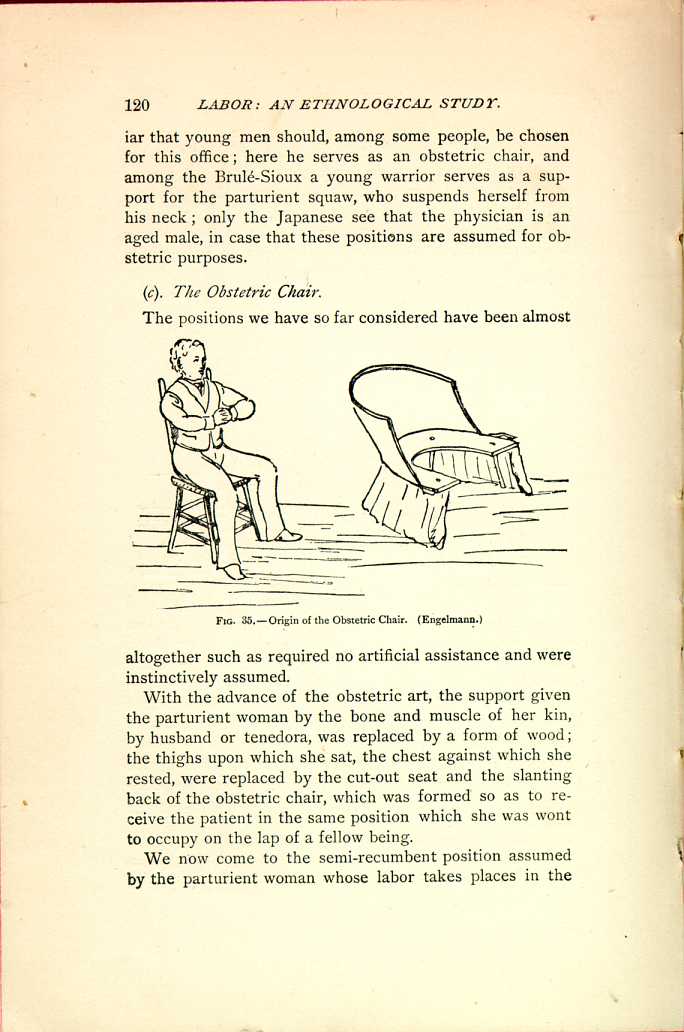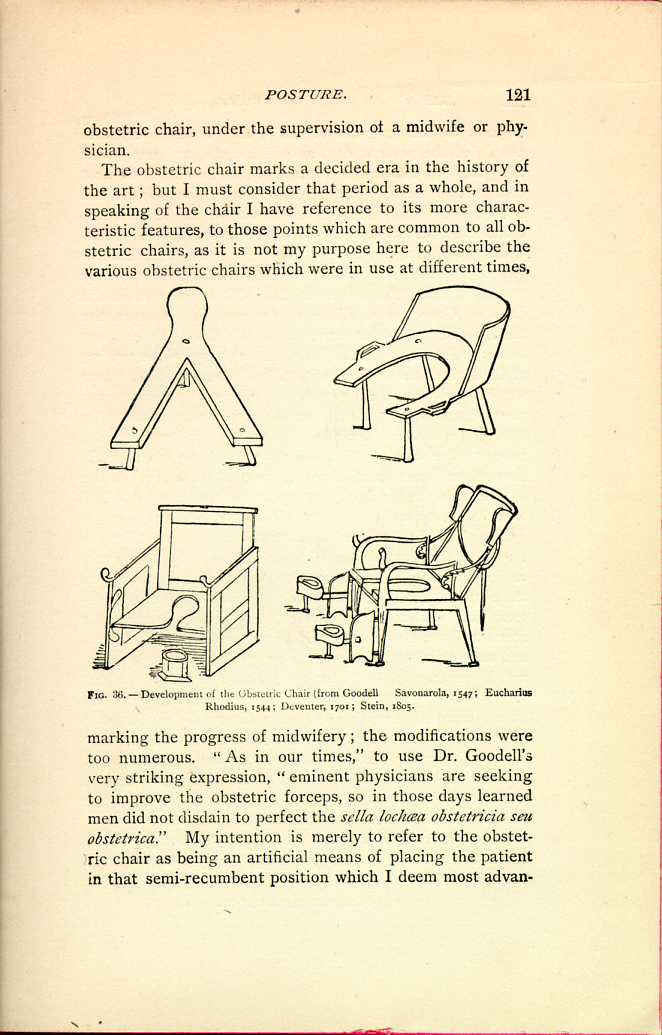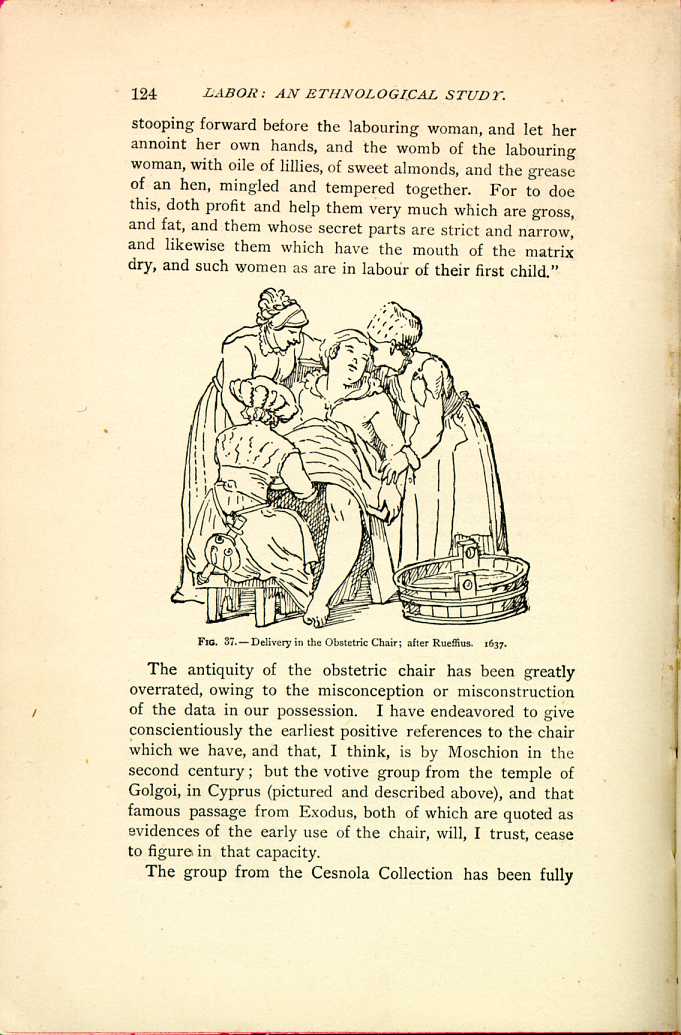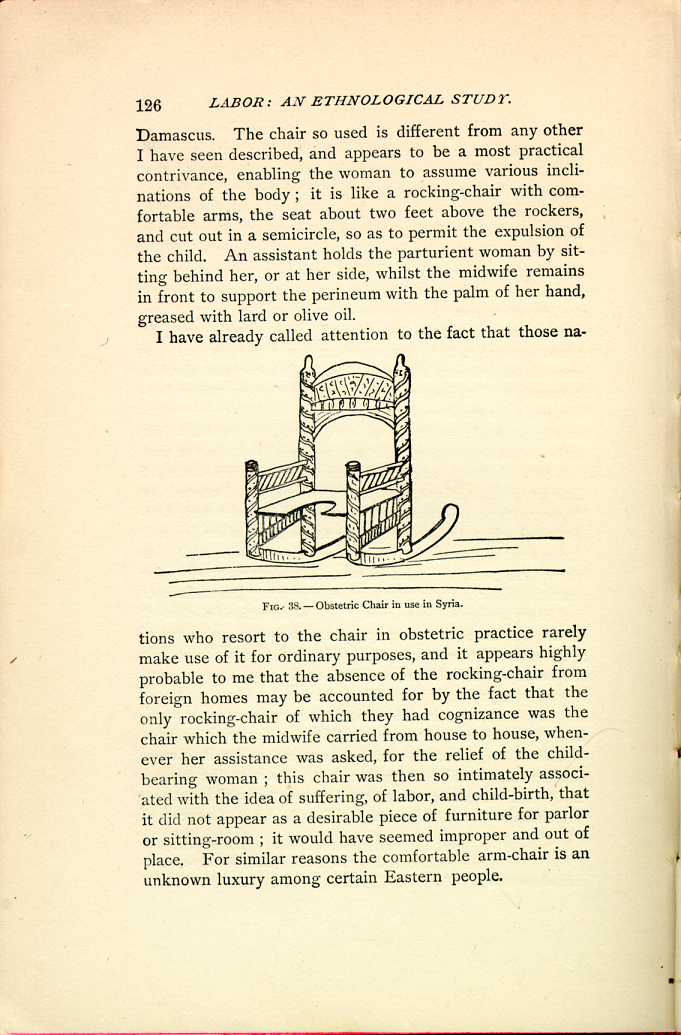| CHAPTER II.
POSTURE IN LABOR. Labor Among Primitive Peoples | ||
(c). The Obstetric Chair.
The positions we have so far considered have been almost

FIG. 35.—Origin of the Obstetric Chair. (Engelmann.)
[Description: Man sitting in chair with legs spread; obstetric chair with
U-shaped seat, providing similar support for back and legs. Black and
white illustration.]
With the advance of the obstetric art, the support given the parturient woman by the bone and muscle of her kin, by husband or tenedora, was replaced by a form of wood; the thighs upon which she sat, the chest against which she rested, were replaced by the cut-out seat and the slanting back of the obstetric chair, which was formed so as to receive the patient in the same position which she was wont to occupy on the lap of a fellow being.
We now come to the semi-recumbent position assumed by the parturient woman whose labor takes places in the
The obstetric chair marks a decided era in the history of
the art; but I must consider that period as a whole, and in
speaking of the chair I have reference to its more characteristic
features, to those points which are common to all obstetric
chairs, as it is not my purpose here to describe the
various obstetric chairs which were in use at different times,

FIG. 36.—Development of the Obstetric Chair
(from Goodell Savonarola, 1547; Eucharius
Rhodius, 1544; Deventer, 1701; Stein, 1805.
[Description: Four different varieties of obstetric chairs are depicted.
Black and white illustration.]
The chair is mentioned by Albertus Magnus in the thirteenth century, and in the German translation of this work, under date of 1589, an illustration is given which resembles the obstetric chair of Soranus and Moschion. In the seventeenth and earlier part of the eighteenth century the chair seems to have flourished in Germany, and also in England, and numerous modifications were introduced. Its supremacy, however, was not of long duration, and it soon yielded to the modern recumbent position, and was only retained by the more conservative people in the rural districts, who follow but slowly in the wake of any advance. Smellie[113] says: "In remote parts of England the patient sat upon a stool made in the form of a semicircle.'' This, of course, was during the time of the decline of the chair, when the dorsal and lateral decubitus had become popular.
In the seventeenth century it was to be found in the centres of medical learning, and had not yet been forced back into the rural wilds.
As a matter of curiosity. I will cite the title of a work published in 1637, in which it was warmly advocated, and I will add a brief description of the chair, in the quaint language of the book, kindly furnished me by Dr. Wise, of the Surgeon-general's Library, and it will answer for this as well as all other chairs, and will serve to show the importance attached to its various features.
"The Expert Midwife: or, an Excellent and most necessary Treatise of the Generation and Birth of Man. Wherein is contained many very Notable and Necessary Particulars requisite to be knowne and practiced: with Divers Apt and Useful Figures appropriated to this Worke. Also the Causes, signes, and Various Cures, of the most Principall Maladies and Infirmities incident to Women. Six Books compiled in Latine by the Industry of James Rueff, a Learned and Expert Chirurgion: and now translated into English for the Generall Good and Benefit of this Nation.''
"Let the stoole be made compassewise, under-propped with foure feet, the stay of it behind bending backward, hollow in the midst, covered with a blacke cloth underneath, hanging downe to the ground, by that meanes that the labouring woman may be covered, and other women sometimes apply their hands in any place, if necessity require. Let the stoole be furnished and covered with many cloths and clouts at the back and other parts, that the labouring woman receive no hurt, or the infant anywhere, strongly kicking and striving because of the paines, stirrings and motions of the mother. And after the labouring woman shall be set in her chaire about to be delivered, the midwife shall place one woman behind her back which may gently hold the labouring woman, taking her by both the armes, and if need be, the pains waxing grievous, and the woman labouring, may stroke and presse downe the wombe, and may somewhat drive and depress the infant downward. But let her place other two by her sides, which may both, with good words, encourage and comfort the labouring woman, and also may be ready to helpe and put to their hand at any time. This being done, let the midwife herselfe sit

FIG. 37.—Delivery in the Obstetric Chair; after Ruegius. 1637.
[Description: Pregnant woman reclines in an obstetric chair, while a midwife and two friends attend her. Black and white illustration.]The antiquity of the obstetric chair has been greatly overrated, owing to the misconception or misconstruction of the data in our possession. I have endeavored to give conscientiously the earliest positive references to the chair which we have, and that, I think, is by Moschion in the second century; but the votive group from the temple of Golgoi, in Cyprus (pictured and described above), and that famous passage from Exodus, both of which are quoted as evidences of the early use of the chair, will, I trust, cease to figure in that capacity.
The group from the Cesnola Collection has been fully
I have already called attention to the fact that those nations

FIG. 38.—Obstetric Chair in use in Syria.
[Description: Obstetric chair designed like a rocking chair, with U-shaped
seat. Black and white illustration.]
It is only within late years that the American rocking-chair has found its way across the ocean, and the increased facilities for intercourse, and the spread of a leveling civilization, will soon do away with these remnants of former times which still linger here and there. Amongst the modern Egyptians, the midwife makes use of a chair, "Kursee El-Wiladeh,'' which is covered with a shawl, or an embroidered napkin, and some flowers of the henna tree, or some roses, are tied with an embroidered handkerchief to each of the upper corners of the back; thus ornamented, the chair is conveyed before the midwife to the house. In the houses of the rich, the parturient is placed on a bed after delivery, and usually remains there from three to six days, whilst the poor women resume their ordinary occupation in a day or two.[116] I will add that Lane, like almost every other author, refers to that passage, Exodus i. 16, intending to compare the custom of using the chair among the Egyptians with that of the ancient Hebrews. In Palestine, the obstetric chair is still an honored institution, but much simplified in form, being sometimes nothing more than an old-fashioned arm-chair.
| CHAPTER II.
POSTURE IN LABOR. Labor Among Primitive Peoples | ||